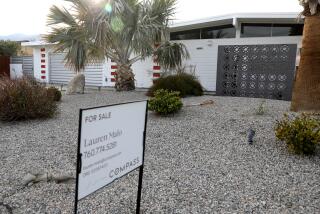Salesmen Warned of Long-Term Damage From Sleazy Sales Techniques
- Share via
NEW YORK — Robert B. Cialdini wrote his book about sleazy sales techniques to warn consumers to be on guard. Now he is frequently invited to speak before the people in charge of the selling.
The 43-year-old professor of psychology at Arizona State University in Tempe spent three years researching his book, “Influence: The New Psychology of Modern Persuasion.” He worked as a used-car salesman, peddled products door-to-door, sold advertising and made “cold calls” on the telephone to learn all the sales pitches.
Now he is on a lecture tour, taking his message to marketing and sales executives, negotiators, attorneys, fund-raisers and the like.
“The people who invited me to come for lectures already understood the process in an inarticulated way,” he said. “That is, they knew what worked, but they wanted to know why it worked. They wanted the psychological underpinnings.”
A ‘Typical Patsy’
Thus Cialdini began speaking more about the ethics of persuasion than the process itself. He says he has a natural interest in the subject because he is a “typical patsy” for a sales pitch.
And, he says, he is not alone. We are socialized in such a way, he says, that if someone gives us something, such as a Hare Krishna flower at an airport, we feel we must reciprocate in some way. We are taught not to interrupt, so we listen to a long pitch on the telephone because we are too polite to just hang up.
Cialdini’s research showed how salesmen take advantage of these common civilities.
He found a fire safety sales pitch to be one of the seamiest: A salesman would come in to make a free inspection of the home and the lucky householder would receive a free fire extinguisher.
“First, the salesman would show pictures of burned children,” he said. “It was just awful.”
After the inspection, he would ask the resident to fill out a questionnaire while he went out to the car to get something.
Building Up Trust
“He would always say, ‘Stay seated. I’ll let myself out and come back in.’ That’s very important. Think of it. Who do you let in and out of your house? Someone you trust. So the salesman has established himself as a trusted person by this simple technique.”
Then came the pitch. It went something like, “Charles, do you think your wife and little girl here are worth $2,000?” What other way can you answer that?
If the potential customer resisted, the salesman would ask permission to call his office to report that he had failed at another sale, a failure that, he explains, might cost him his job. On the phone the front office, all part of the central plot, would explain that he could offer the products for $500 less, since his job was on the line.
Cialdini also took breathing lessons so he could make a pitch on the telephone without taking a breath and giving the other party a chance to say, “I’m not interested.”
He said consumer groups have shown little interest in his book, but the interest it engendered in corporate America has changed his life.
A Dream ‘Boondoggle’
“IBM flew me to Monte Carlo for a month--twice--for big educational conferences,” he said. “That’s the kind of boondoggle I always read about somebody else getting, but I got it, and they paid me money besides.”
He gets $3,500 for each lecture, or $5,000 for half a day, but he has had to cut his speaking down to twice a month. He is back teaching psychology after a sabbatical.
Cialdini said he is pleased that the book did not turn him into a “pop psychologist” and that he did not lose academic standing because of it.
The book, published in 1984 and re-issued as an academic text in 1988, outlines the six “triggers” to which people respond in decision-making: authority, reciprocity, scarcity, commitment, consensus and liking.
In discussing the authority technique, Cialdini offers an ethical and unethical use.
If nine out of 10 doctors really did prefer a certain brand, that’s one thing, he says, but it’s something else to have an actor whom the public identifies with a physician role endorsing a decaffeinated coffee.
Detectives and Smugglers
Cialdini describes the difference as the “detective” approach and the “smuggler” approach. The detective approach is to find naturally hidden triggers in the product. The smuggler approach is to create them, as with the actor in a white doctor’s coat endorsing a product.
Let’s say you have spent about half an hour with a used-car salesman. Do you feel as though you like him? If the answer is yes, watch out. You are being manipulated. The question is whether the price on the car is a good deal.
That technique explains the success of products such as Tupperware, Avon, and Mary Kay, he says. The seller of such a line is likely to be a friend, or at least an acquaintance.
Let’s say you are looking at a house to buy and your real estate agent becomes aware that another family is also interested. He tells you that someone else might get it. That is perfectly legitimate. He’s acting in your best interest. In an unethical scenario, however, there is no other buyer out there. The agent creates one to get you to put down a firm bid.
Deceptions and Ethics
How do you know when it’s real?
Unfortunately, often, you don’t.
“That’s why all salesmen tend to get tarred with the same brush and end up ranking down there below undertakers,” Cialdini said.
“When I talk to business groups, the point I make is that they are going to do better in the long term by being ethical,” he said. “Then they sit up and take notice.”
He uses as an example a trusted mechanic who told him the repairs necessary on his car would be $45. The previous mechanic had estimated $500.
“He was very ethical and he now has me as a customer for life,” Cialdini says.
The research he put in on his book gave him one more advantage, he says.
“I can say no a lot better now.”
More to Read
Inside the business of entertainment
The Wide Shot brings you news, analysis and insights on everything from streaming wars to production — and what it all means for the future.
You may occasionally receive promotional content from the Los Angeles Times.










